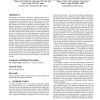169
Voted
FPGA
2006
ACM
15 years 4 months ago
2006
ACM
In this paper, we propose a technique to flexibly implement genetic algorithms for various problems on FPGAs. For the purpose, we propose a basic architecture for GA which consist...
143
Voted
ECML
2004
Springer
15 years 4 months ago
2004
Springer
Abstract. This paper presents an empirical study of population diversity measure and adaptive control of diversity in the context of a permutation-based algorithm for Traveling Sal...
86
Voted
CIAC
2006
Springer
15 years 4 months ago
2006
Springer
Consider a truck running along a road. It picks up a load Li at point i and delivers it at i, carrying at most one load at a time. The speed on the various parts of the road in on...
114
click to vote
CAAN
2006
Springer
15 years 4 months ago
2006
Springer
In this paper we improve the quality of a recently suggested class of construction heuristics for the Asymmetric Traveling Salesman Problem (ATSP), namely the Contract-or-Patch heu...
105
Voted
ANTSW
2006
Springer
15 years 4 months ago
2006
Springer
There are two reasons for parallelizing a metaheuristic if one is interested in performance: (i) given a fixed time to search, the aim is to increase the quality of the solutions f...
ICLP
1997
Springer
15 years 4 months ago
1997
Springer
This paper presents a set of techniques that makes constraint programming a technique of choice for solving small (up to 30 nodes) traveling salesman problems. These techniques in...
101
click to vote
ESA
1998
Springer
15 years 4 months ago
1998
Springer
Previous literature on the Traveling Salesman Problem (TSP) assumed that the sites to be visited are stationary. Motivated by practical applications, we introduce a time-dependent ...
137
click to vote
IPPS
1998
IEEE
15 years 5 months ago
1998
IEEE
Parallel genetic algorithms (PGAs) have been developed to reduce the large execution times that are associated with serial genetic algorithms (SGAs). They have also been used to s...
108
Voted
IJCNN
2000
IEEE
15 years 5 months ago
2000
IEEE
In our recent work, a general method called the stable state analysis technique was developed to determine constraints that the weights in the Hopfield energy function must satisf...
109
click to vote
CCO
2001
Springer
15 years 5 months ago
2001
Springer
Abstract. The first computer implementation of the Dantzig-FulkersonJohnson cutting-plane method for solving the traveling salesman problem, written by Martin, used subtour inequa...



